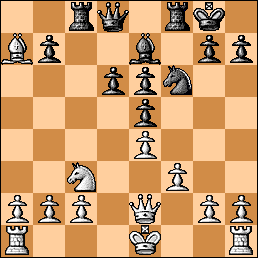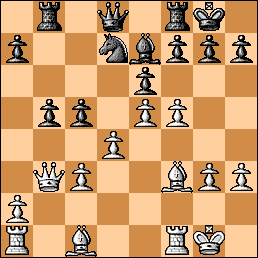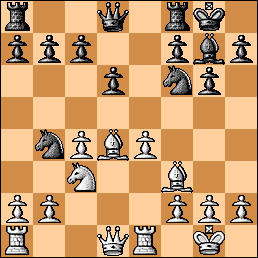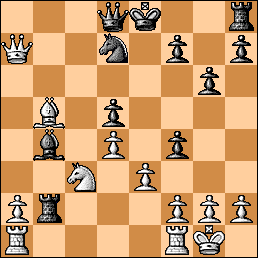The March 2008 Tulsa, Oklahoma US Championship Qualifier had some interesting games from the perspective of chess theory. Let’s see some of these perpetual time pressure games (G/90 + 30 sec increment). Endings suffered, and opening familiarity rose to the foreground. See this background post for some Tulsa “glamor shots.”
GM Alex Yermolinksy – NM Movses Movsisyan, Round 2. Gruenfeld Defense.
1.d4 Nf6 2.c4 g6 3.Nc3 d5 4.cxd5 Nxd5 5.e4 Nxc3 6.bxc3 Bg7 7.Nf3 c5 8.Be3 cxd4 Here, 8…Qa5 and 8…O-O are the most popular. Strangely, black plays a burst of natural but rare moves and emerges with a good game!
9.cxd4 Bg4 9…Qa5+ 10. Qd2 Qxd2+ was a quick draw in Groszpeter-Farago, Bibinje 2006, but white has a small edge after 11. Kxd2 Nc6 12. Rb1 (12. Rc1 was played).
10.Be2 Nc6 11.d5 (What else?) 11…Ne5 12.Nxe5 Bxe2 13.Qxe2 Bxe5

Position after 13…Bxe5.
14.Rd1?! Previously, the lame 14. Qb5+? Qd7 led nowhere in Gorshkov-Zilberstein, Sverdlovsk 1979, and drawn in 30 moves. However, 14. Rc1! looks more useful than the artificial text move. After all, 14. Rc1! Qa5+ 15. Qd2 Qxd2+ 16. Kxd2 with f2-f4 coming is a solid ending edge for white.
14…Qa5+ 15.Bd2 Qa4! With simple moves, black has achieved a good game against the experienced grandmaster. Note that Yermo provided several good wins of his vs. the Gruenfeld in his book “The Road to Chess Improvement.” This indicates that black’s particular Gruenfeld choice in this game warrants further study. Well, maybe not, since white did have the stronger 14. Rc1! in the game.
16.Bh6 Qb4+ After 16…Rc8 17. O-O Rc2, black has full equality. For example, 18. Qd3 Rxa2 19. Rc1 Ra3 20. Qe2 Ra2 21. Qf3 Ra3 is a perpetual attack on the queen and draw.
17.Kf1 Rc8 18.g3 Rc4 19.Re1 Bc3 19…Qa4! eyeing c2 is strong. Then, 20. Kg2 f6 makes an escape hatch for black’s king and once again he is happy.
20.Rc1 Rxe4?? Black ruins everything with a dreadful tactical oversight. 20…b5 was fine. For example, 21. f3 Be5 22. Kf2 Kd7! with equality.
21.Qc2 Rc4 22.Bg7! Oops. Undoubtedly overlooked by black. The rest of the game is technique.
22…Bxg7 23.Qxc4 Qxc4 24.Rxc4 Kd7 25.f4 b5 26.Rc6 Rb8 27.Ke2 b4 28.Ra6 Rb7 29.Rb1 Bc3 30.Kd3 Rc7 31.Rc1 Rc5 32.Rxa7+ Kd6 33.Ke2 33. a3 is a simple win. 33…Rxd5+ 34. Kc4! Rd4+ 35. Kb3 Rd3 36. axb4! Bd4+ 37. Kc4! does the trick. The text is fine too. White will win this.
33…Rxd5 34.Rd1 Rxd1 35.Kxd1 Bd4 36.Rb7 Bc5 37.Ke2 Kc6 38.Rb8 Kd5 39.Kd3 e5 40.fxe5 Kxe5 41.Rb7 Ke6 42.g4 Bd6 43.h3 h6 44.Ke4 f5+ 45.gxf5 gxf5+ 46.Kf3 Be7 47.Rb8 Kf6 48.Rg8 Bd6 49.h4! Iron-clad. 49…Kf7 50.Rg2 Be7 51.h5 Bg5 52.Rc2 Ke6 53.Rc6 Kd5 54.Rb6 Kc5 55.Rg6 Bd2 56.Ke2 Bc1 57.Rf6 Kb5 58.Rxf5 Ka4 59.Kd3 Bb2 60.Kc4 Bc3 61.Rd5 Ka3 62.Rd6 Kxa2 63.Rxh6 Bd2 64.Rd6 Bc3 65.h6 Kb2 66.h7 Kc2 67.Rh6 Bh8 68.Kxb4 Kd3 69.Re6 1-0
IM Blas Lugo – GM Jesse Kraai Round 4, French Exchange
1.e4 e6 2.d4 d5 3.Nc3 Nf6 4.Bg5 dxe4!? 5.Nxe4 Be7 A favorite treatment of GM Evgeny Bareev. This is not as quiet as it appears since the kings wind up on opposite sides often. It has the advantage of avoiding many long mainline theory variations.
6.Bxf6 Bxf6 7.Nf3 Nd7

Position after 7….Nd7. Decision Time.
8.Qd2 Maybe it’s just me, but I think a planned Bishop placement on d3 warrants a queen on e2 more than a queen on d2. For example, 8. Bd3 O-O 9. Qe2 c5!? 10. O-O-O cxd4 11. h4!? with ultra sharp play (eventually drawn) in Sutovsky-Ivanchuk, Moscow 2002. Both this plan and the text have been seen in dozens of games, of course.
8…O-O 9.O-O-O Be7 10.Bd3 b6 11.Kb1 The primitive 11. h4 turned out to be too slow in Suetin-Bareev, Hastings 1991, and black won after 11…Bb7 12 Kb1 Nf6. To give a counter-example, White won after 11. h4 Bb7 12. c3!? Nf6 13. Neg5 Bxf3 14. gxf3, but this position is equal after 14…Qd5. Black played 14…Kh8?! and lost in Topalov-Dreev, Linares 1995. The text move, on the other hand, also doesn’t promise much – only 3 draws in Chessbase’s BigBase. A more dangerous try is 11. Neg5!? which hopes for 11…h6? — after 11. Neg5 h6?, white scored +4 =0 -0 in ChessBase!

Position after 11. Neg5!? (Analysis). Black has to be careful.
But there’s a curiosity here: in Volokitin-P.H. Nielsen, Germany 2004, the game went 11. Neg5 h6 12. Bh7+ Kh8 13. Be4 which at first glance looks good for white. However, upon reflection doesn’t it look like black missed 13…hxg5 14. Bxa8 g4! and the threat of Be7-g5 wins material? We will come back to this. In the game, black played 13…Bxg5 14. Nxg5 Rb8 and lost. However, he was doing OK after 15. Nf3 Nf6 16. Bc6 Qd6 17. Ne5 Ng4! 18. Nxg4 Qc6 – he only lost due to later middlegame miscues. The truth about 13…hxg5? is revealed in another example, J. Polgar – F. Berkes, Budapest 2003, white introduced an incredible gambit: 12. Bh7+ Kh8 13. Be4 hxg5? 14. g4!! (not the greedy 14. Bxa8?) and now black faces complex problems. White stops black from playing g5-g4 and prepares to open the h-file. In the game, black lost after 14…Rb8 15. h4 g6 16. hxg5+ Kg7 17. Qf4 and white crashed through. The question is, can black live after 14. g4? Let’s take a look. First of all, 14….Ba6 15. h4! gxh4 16. g5! is crushing. For example, 16…Kg8 17. Rxh4 f5 (What else?) 18. Bc6 Rc8 19. Rdh1 Kf7 20. d5! and wins. Let’s go back to Berkes’s choice, 14…Rb8. 15. h4 and first we see that 15…gxh4? is bad: 16. g5 g6 17. Rxh4+ Kg7 18. Rdh1 Rg8 19. Rh7+ Kf8 20. Qf4! and wins.
So we go to Berkes choice, 15…g6 16. hxg5+ Kg7 17. Qf4. This is critical. We first notice that 17…Ba6 is crushed by a typical Judit Polgar brute-force tactic 18. Rh7+!! Kxh7 19. Qh2+ Kg8 20. Rh1 Bxg5+ 21. Nxg5 Qxg5+ 22. f4! and wins. We also notice that Berkes’s choice, 17…Bb7?, was crushed by the same tactic.
what about 17…Rh8!? – trying to defend on the h-file. There follows 18. Rxh8 Qxh8 (forced) 19. Ne5! and now black cannot take: 19…Nxe5? 20. Qxe5+ Kg8 21. Qxc7 Bxg5+ 22. Kb1 and the rook on b8 is trapped; white wins. And after 19…Qe8 20. Rh1! the lethal threat of 21. Nxf7! is introduced. Black still cannot take on e5 and hence is lost.
Going back to the beginning, 11. Neg5!? is best met by 11…Bxg5! and now 12. Qxg5 Qxg5+ 13. Nxg5 Nf6 is dead equal. Or, 12. Nxg5 Nf6 and black is OK and even won in B. Lopez-Kraai, San Diego 2004. That game continued 13. Qf4 Bb7 14. Rhe1 Qd6!? and here white disdained an equal ending after 15. Qxd6, opting for 15. Qh4 h6 16. Nf3 (16. Ne4! equal) Bxf3 17. gxf3 Nd5 18. Re4, eventually getting into trouble with the weak d4 pawn. White tried 13. h4!? in Sax-Dizdar, Celje 2003, and black reacted suspiciously with 13…c5?! 14. dxc5 Qd5 15. Kb1? Qxc5 equal. But white missed 15. Qf4!! Qxa2 16. Nxh7! Nxh7 17. Qe4 Nf6 18. Qxa8 Qa1+ 19. Kd2 Qxb2 20. Qxa7 and white keeps a small plus. Stronger is 13. h4 Bb7! and black is fine.
11…Bb7 12.Qf4 c5 In Sindik-Dizdar, Pula 1993, black introduced an idea similar to the game a little earlier: 12…Qb8!? 13. Qg3 c5! with good play. White can improve with 13. Ne5! c5 14. Bb5! Nf6 with sharp play after 15. Nxf6+ Bxf6 16. Rhe1 and now the Korchnoi pawn grab 16…Bxg2!?
13.dxc5 Qb8! Gambits in opposite-castled king positions are effective even in the ending! This is particularly true in the “perpetual time pressure” time control of G/90+30 sec. This motif, although it has been seen before, is ingenious and disconcerting for white. There is no more attack and white has to switch gears (notoriously difficult) to a defensive up-a-pawn but under pressure mode.

Position after 13….Qb8! – A gambit to reach an ending!
14.Qxb8 Raxb8 15.cxb6 Nxb6 16.b3? Correct is the solid but not particularly easy to find 16. Ned2! and then a defensive hunkering down. This would not create the glaring c3 weakness in the game. White would then have enough counter-chances.
16…Na4! Very unpleasant to meet in this time control. White probably overlooked this. The c3 square is now home for black’s knight.
17.Rde1 Bxe4 18.Bxe4 Nc3+ 19.Kb2 Bf6 This position is terrible for white.
20.Bd3 Ne4 21.Kb1 Nxf2 22.Rhf1 Nxd3 23.cxd3 Rfd8 24.Re3 a5 25.Ne5 Rd5? Correct is 25…Bxe5 26. Rxe5 a4! and black is on top. For example, 27. Kc2 axb3+ 28. axb3 Ra8 29. Kc3 Ra2 with a huge initiative.
26.Nc6 Rb7 27.Rg3 Kf8 28.Rf4! White is doing the right things now to get back in the game.
28...Be5 29.Nxe5 Rxe5 30.Rc4 f5 31.Rf3? 31. Kc1!
31…Ke7 31…Re2! is strong. 32.Rf2 Rd7 33.Kc2 Red5 34.Rf3 Kf6 35.Kc3 g5 36.d4? 36. h4! to reduce the number of pawns.
36…f4 37.a3 Kf5 Now black is gaining control again with his monstrously active king.
38.Rc5? White had to wait with 38. Rf2. The pseudo-active text is crushed.
38…g4 39.Rf1 e5! White probably underestimated this.
40.Rxd5 Rxd5 41.dxe5 Rxe5 42.Kd2 h5 43.b4 axb4 44.axb4 h4 45.Rb1 f3 46.gxf3 gxf3 47.b5 Kg4! The key move. White is lost.
48.b6 f2 49.b7 Re8 50.Rb4+ Kh3 51.Rb3 Kg2 52.b8Q Rxb8 53.Rxb8 f1Q 54.Re8 0-1
In more Round 4 action:
GM John Fedorowicz – FM Michael Langer Modern Benoni
1.d4 Nf6 2.c4 c5 3.d5 e6 4.Nc3 exd5 5.cxd5 d6 6.Nf3 g6 7.Nd2 Nbd7 8.e4 Bg7 9.Be2 O-O 10.O-O Re8 11.a4 Ne5 12.Qc2 g5 13.Ra3 Fischer defeated the lame 13. Nf3?! Nxf3+ 14. Bxf3 h6 in Gligoric-Fischer, Palma de Mallorca 1970 Interzonal. White has equality here but Gligoric soon made a fatal tactical miscue. The text move is an idea of Petrosian’s; but will it “work” along the 3rd rank or get stuck?

Position after 13. Ra3. How useful will this rook be?
13…g4 14.Nd1 Ng6!? The very interesting 14…Nh5!? was seen in Antunac-Y. Gruenfeld, New York 1981, and black managed to win eventually. The game proceeded 15. Ne3 Nf4 16. Bd1 and black was very active. If 15. Re1 Nf4 16. Bf1 Neg6 and black is also OK and drew in 23 moves, Karolyi-Poloch, Leipzip 1984. The most active move, 15. f4!?, might be good for white but prior games misplayed both sides: 15…gxf3 16. Nxf3 Ng6?! 17. Ng5? (17. Bg5! with edge) and drawn eventually, Koualty-Renet Marseille 1988. Or 16…Nxf3+ 17. Bxf3 (17. Raxf3 is a white edge) 17…Be5?? 18. g3?? and white even lost in 40 moves, Nowak-Pokojowczyk Zielona Gora 1982. Black’s 17th move was complete bluff and white could win with the very nice 18. Bxh5 Qh4 19. Rg3+! (Ouch!) 19…Bxg3 20. Bxf7+ Kg7 21. hxg3 Qxe4 22. Bh6+!! Kxh6 23. Qc1+! Kg7 24. Qg5+ and now black must lose his queen with the sad 24…Qg6 – so it’s resignable.
Tentative Conclusion: 15. f4! is the best move after 14…Nh5!?
The natural move 14…Bd7!? is also very interesting. White gets in trouble after the lemon 15. Bb5? Bxb5 16. axb5 Qb6!. No edge for white is to be seen in this position. After the text move, black has enough counter-chances as well.
15.Ne3

Position after 15. Ne3.
15…Qe7?! 15…Nf4! is a good choice. Witness the nifty defusing tactic: 16. Bb5 Bd7! 17. Bxd7 (apparently gaining the monster square f5 for the knight) 17…Ne2+!! 18. Kh1 Qxd7 19. Nf5 Nd4! with equality. A very nice defensive motif. There is also 16. Bc4 and here is a crazy repetition draw line: 16. Bc4 Bd7 17. f3!? gxf3 18. Rxf3 Bh6 19. Kh1 Bg5 20. Rg3 N6h5 21. Rf3 Nf6 22. Rg3. Unforced, but you get the idea. Putting the queen opposite the white rook (soon to arrive on e1) will have nasty consequences in the game.
16.Bb5 Rd8 17.a5 Not much is accomplished by 17. f4 gxf3 18. Rxf3 a6 19. Bd3 Ne5 with equality.
17…Nf4 17…a6 is possible. If 18. Ba4 Nf4 19. Re1 with a small white edge.
18.Re1 h5 19.Qd1 h4? Again, the careful 19….a6 is good to include. For example, 20. Bf1 Re8 and all is well. More dangerous is 20. Ba4! Rb8 21. Bc2! with a latent attack in the works. The impulsive text is an example of going overboard in a Modern Benoni. Just because the opening is an active choice does not mean every single move has to be maximally active even at the cost of weakening.
20.Nf5! The punishment. Black’s king is too weak now.
20…Bxf5 21.exf5 Qf8 22.Ne4 N4xd5 23.Bg5 Note that 23. a6! is crushing.
23…Nxe4 24.Rxe4 Nf6 25.Bxf6 25. Re1 with the idea of Bxh4 would win easily also.
25…Bxf6 26.Rxg4+ Kh7 27.Qd5 Black is paralyzed.
27…Qe7 28.Re3 Qc7 29.Rxh4+ 29. Qe4 with the idea of 30. Rxh4+ was total butchery. The text also wins quickly.
29…Bxh4 30.f6 Kg6 31.Re7? 31. Bd3+ is a fast forced mate. 31…Kxf6 32. Qf5+ Kg7 33. Qh7+ Kf6 34. Qh6 mate. Accuracy is often a victim at this crazy time control (or maybe white was playing on black’s clock). Of course, the text wins easily as well.
31…Qxe7 32.fxe7 Bxe7 33.Bc4 Rf8 34.Qe4 Kf6 35.Qh4 Ke5 36.Qxe7 Kd4 37.Bf1 1-0
Let’s move on to a real barn burner between two strong Grandmasters.
Round 5. GM Goldin – GM Yermolinsky Slav Defense
1.d4 d5 2.c4 c6 3.Nf3 Nf6 4.e3 Bf5 5.Nc3 e6 6.Nh4 Be4 7.f3 Bg6 8.Qb3 Qc7

Position after 8…Qc7. To 9. g4 or not to 9. g4.
9.Bd2 GM Vadim Milov, a connoisseur of opening theory, played 9. g4!? here and won after 9…Be7 10. g5!? Nfd7 (10…dxc4!) 11. Nxg6 hxg6 12. f4 f6? (12…dxc4!) 13. Bd2 with a big edge; Milov-Rogozenko, Istanbul 2000. If black had played the correct dxc4! on either move 10 or move 12, he would have had equal chances. Goldin’s natural move has also been seen.
9…Be7 10.Nxg6 Karpov got nowhere with 10. g3 Bh5! and drawn in 31 moves, Karpov-Bacrot Cannes 2000. 10. cxd5!? looks stronger. After 10…cxd5 11. Nxg6 hxg6 12. Bd3 Nc6 13. O-O-O, black missed the mirror move 13…O-O-O! and lapsed with 13…a6, going on to lose in Malakhov-Volkov, Sochi 2004.
10…hxg6

Position after 10…hxg6. A very critical moment. To cackle or not to cackle?
11.Rc1 This is an important moment. Van Wely was successful twice (vs. Volkov and Sokolov) with 11. O-O-O! here. For example, 11. O-O-O Nbd7 12. cxd5! Nxd5 13. Kb1 Nxc3+ 14. Bxc3 and white is clearly better (Van Wely-Sokolov, Amsterdam 2002, and 1-0, 55 moves. Or, 11. O-O-O a6 12. Kb1 dxc4 13. Bxc4 b5 14. Bd3 Rxh2 and here, 15. Ne4! is strong with white advantage (15. g4?! was played, but white won a long game anyway, Van Wely-Volkov, Panormo 2002, 1-0, 79). After 11. O-O-O, 11…dxc4!? looks critical. 12. Bxc4 b5 13. Be2!? a6 14. Kb1?! was Tregubov-Bareev, and black won a tough struggle, 0-1 40 moves, Venacu 2006. It’s easy to find improvements for white. First of all, in the game, 14. e4! is strong (14…Rxh2? 15. e5! with a big edge). Secondly, the more active 13. Bd3!? (with Nc3-e4 ideas) is a tricky try one move earlier. Black’s position is very dangerous after 13…Rxh2 14. Qc2!. Conclusion: 11. O-O-O! is strong!
11…Nbd7 12.cxd5 exd5 12…Nxd5! is fine for black. For example, 13. e4 Nxc3 14. bxc3 Bh4+! (the point!) and black is happy.
13.e4 13. g3 Bd6 got white nowhere in Chiburdanidze-Zhukova, Istanbul 2000, and drawn in 16 moves.
13…dxe4 14.fxe4 Rxh2 14….Rd8! is perfectly good for black. The text is OK too but chances are still balanced. We are now out of book and it’s …. about even.
15.Rxh2 Qxh2 16.Qxb7 The computer move 16. e5 is playable. One humorous line is 16…Nxe5!? 17. dxe5 Qxe5+ 18. Kd1 Rd8 19. Qxb7?? Qf4! and wins.
16…Rb8 17.Qxc6 Rxb2 18.Nb5 Qh4+ 19.Kd1 Qf2

Position after 19…Qf2. White falls on his own Claymore.
20.Qa8+?? A horrific blunder that loses on the spot. 20. Qc8+! is drawn. For example, 20…Bd8 21. Be2 Qg1+ 22. Be1 Qe3 (or 22…Nxe4 23. Nc7+ Ke7 24. Nd5+ with a perpetual check) 23. Rc2! (guarded by the queen!) Rb1+ 24. Rc1 Rb2 25. Rc2 with a repetition. White must have missed something very simple.
20…Bd8 21.Be2 Qg1 22.Be1 Qxg2 Oops. There is no 23. Rc2 defense because the white queen is on a8, not c8. So white could already resign.
23.Bd2 Qg1 24.Be1 Qe3 25.Rc8 25. Nc7+ Ke7 is just a spite check.
25…Qxe2+ 26.Kc1 White has seen enough and resigns before black can play 26…Rxb5. An unusual collapse on Goldin’s part.
0-1
Here’s an important last round game – the winner qualified for the US Championship (to be held also in Tulsa). Once again the Gruenfeld triumphed.
IM Salvijus Bercys – GM John Fedorowicz Round 7, Gruenfeld Defense
1.d4 Nf6 2.c4 g6 3.Nc3 d5 4.cxd5 Nxd5 5.e4 Nxc3 6.bxc3 Bg7 7.Nf3 c5 8.Be3 Qa5 For 8…cxd4, see Yermolinsky-Movsisyan discussed above.
9.Qd2 O-O 10.Rc1 The most popular, but 10. Rb1 is a major alternative. Statistically, 10. Rb1 scores a little better.
10…Rd8 11.d5 e6 12.c4 Qxd2 13.Nxd2 b6 14.Be2 Na6 15.O-O GM Khenkin is a proponent of the weird 15. Nb1!?. After 15. Nb1 f5 16. f3 fxe4 17. fxe4 Bb2 18. Rd1 exd5 19. cxd5 Re8 the chances were balanced and the game was drawn in 24 moves, Khenkin-Gutman Bad Wiessee 2002.
15…Nb4 Still the mainline, we are following 18 games in ChessBase. Nevertheless, the position appears to promise zero for white so it’s a mystery why it has occurred so often.
16.a3 Na2 Black’s knight wanderings are actually very logical. White has proven nothing in practice starting from this point.

Position after 16…Na2. White has nothing.
17.Rc2 Nc3 18.Bd3 White plays a slightly less common move now. The most common move is the awkward looking 18. Bf3. However, black won after 18. Bf3 exd5 19. cxd5?? (19. exd5! Bf5 20. Rcc1 equal) 19…Ba6 20. Rfc1 Ne2+ 21. Bxe2 Bxe2 22. f3 Bd3 with an obvious advantage, R. Stone – Ilya Gurevich, Chicago 1992.
18…Ba6 19.Bg5 Some white players have preferred 19. Nb1? here, but it’s just a blunder after 19…exd5 20. Nxc3 d4 with a big black edge after 21. Nd5 dxe3 22. fxe3 Be5.

Position after 19. Bg5. Time for a surprise!
19…exd5!? TN I have not been able to locate this move, hence I am labeling it a Theoretical Novelty (TN). Previously seen was 19…Rd7!? and black has quite a good game. For example, 19…Rd7 20. Rfc1 h6 21. Bf4 exd5 22. Rxc3 Bxc3 23. Rxc3 g5 24. Bg3 dxc4 25. Nxc4 Rd4 26. Bf1 Rad8 27. f4?? Rxe4 and black went on to win, Tunik – Timofeev, St. Petersburg 2002. 27. f3! of course was correct with an equal game. The conclusion is that the entire line is harmless. White has to seek improvements earlier.
At this point, according to Monroi, black had spent 1 minute and 30 seconds executing all these moves! The sacrifice is made even more attractive by the fact black is not risking anything. His position is very solid after white grabs the exchange with the bishop pair and an extra pawn.
20.Bxd8 White, surprised, took 8 minutes on this and now had 1:02 remaining.
20…Rxd8 21.exd5 Nxd5 22.Re1 Nf4 23.Bf1? Passive. White only spent one minute on this clunker. 23. Be4! is clearly stronger. White is in no danger after 23…Ne6 24. Nf3 Bf6 25. g3. Or, 23…Nd3? 24. Bxd3 Rxd3 25. Re8+ and white is too active.
23…Ne6 24.Nb3 Weird. 24. Nf3 is more natural.
24…Bb7 25.a4?! White’s moves are all connected to a poor plan of queenside action. He could have still bailed out with 25. Rd2 and a likely draw.
25…a5 26.Ra2 Bc3 27.Rc1 Bb4 28.f3?! 28. Be2, guarding d1 and contemplating Rd1, looks better.
28…Bc6 29.Kf2 Kg7 30.Be2 Nd4 31.Nxd4 cxd4 32.Bd3 Re8 33.Be4? This move, losing a key pawn, is too cavalier and should just lose. Most players would just wait. However, black reacts inaccurately to give white one more chance on move 40.
33…Bxe4 34.fxe4 Rxe4 35.Rd1 Bc5 36.Rd3 f5 37.Re2 Kf6?! The clever 37….g5! is stronger here to rule out the white possibility mentioned in the note to white’s 40th move.
38.h3 h5?! And here, black had 38…Rf4+ and a later …g5, or 38…g5 right away. The idea is to take away h3-h4 for white.
39.Kf3 Ke5

Position after 39…Ke5. Last Chance.
40.Rd1? The last chance to resist was 40. h4! to hold black up on the kingside. White might even be able to hold the position with careful play; it’s up to black to demonstrate progress.
40…g5! Now it’s really all over. The rest is torture.
41.Rd3 Bb4 42.Rd1 Bc5 43.Rd3 g4+ 44.Kf2 h4 45.Kf1 Bb4 46.Rd1 Rxe2?! The simplest is 46… gxh3 47. gxh3 f4 with total domination.
47.Kxe2 Ke4 48.Rf1? Very bad. White has to try to hold the 3rd rank with 48. Rd3 and make black demonstrate a plan.
48…d3+ 49.Kd1 gxh3 50.gxh3 f4 51.Rg1 f3 52.Rg6 f2 53.Rf6 Bc5 White is paralyzed and gives up.
0-1























































